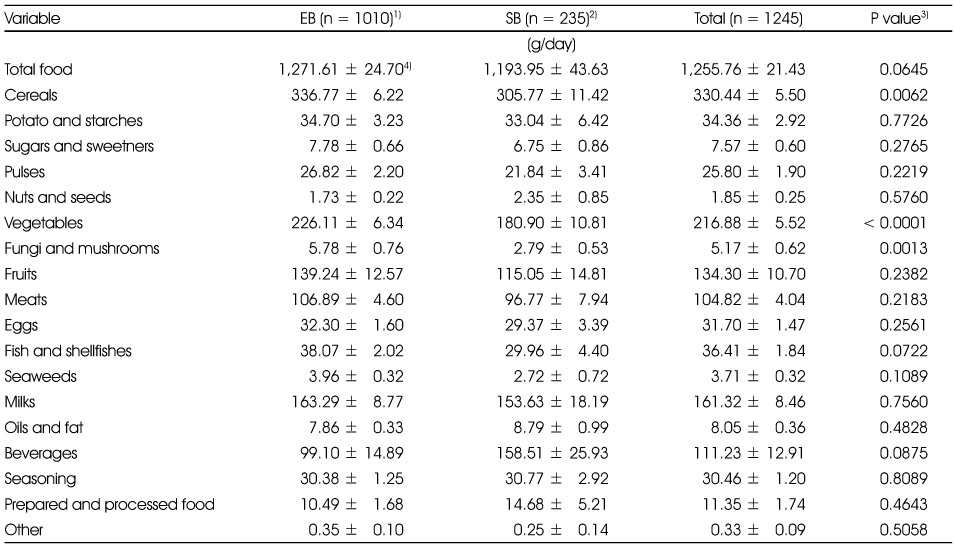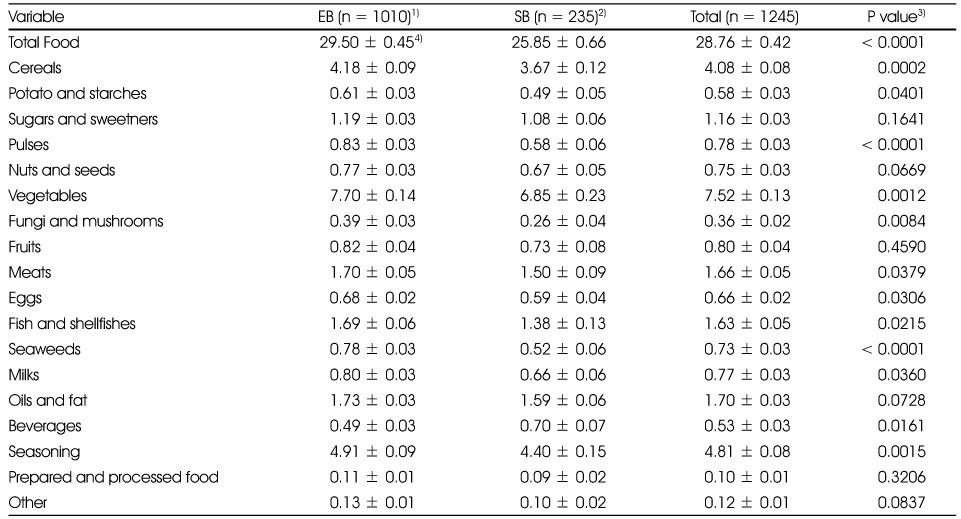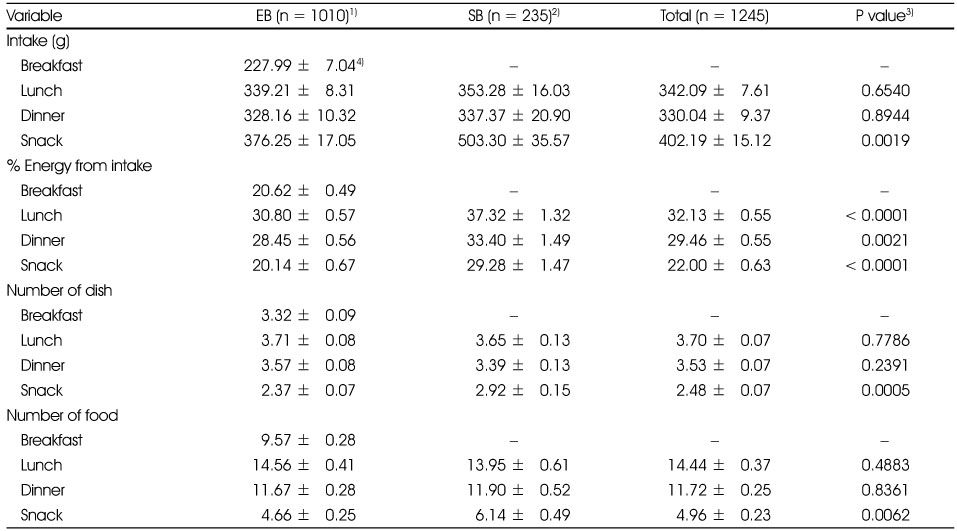Articles
- Page Path
- HOME > Korean J Community Nutr > Volume 18(3); 2013 > Article
-
Original Article
- Evaluation of Nutrient Intake and Meal Variety with Breakfast Eating in Korean Adolescents: Analysis of Data from the 2008~2009 National Health and Nutrition Survey
- Yun-Jung Bae
-
Korean Journal of Community Nutrition 2013;18(3):257-268.
DOI: https://doi.org/10.5720/kjcn.2013.18.3.257
Published online: June 30, 2013
Department of Food and Nutritional Sciences, Hanbuk University, Gyeonggi, Korea.
- Corresponding author: Yun Jung Bae, Hanbuk University, 233-1, Sangpae-dong, Dongducheon-si, Gyeonggi-do 483-777, Korea. Tel: (031) 860-1445, Fax: (031) 860-1449, byj@hanbuk.ac.kr
Copyright © 2013 The Korean Society of Community Nutrition
This is an Open-Access article distributed under the terms of the Creative Commons Attribution Non-Commercial License (http://creativecommons.org/licenses/by-nc/3.0/) which permits unrestricted non-commercial use, distribution, and reproduction in any medium, provided the original work is properly cited.
- 1,106 Views
- 4 Download
- 17 Crossref
Abstract
- The purpose of this study was to evaluate nutrient intake and meal variety with breakfast eating in Korean adolescents using data from the 2008-2009 National Health and Nutrition Examination Survey. The analysis included 1245 adolescents aged 12 to 18 years. The subjects were divided into two groups according to breakfast skipping (BS: breakfast skipping, n = 235, BE: breakfast eating, n = 1110). The BS group was significantly higher in its frequency of eating soda drinks, instant noodle, and ice cream than the BE group. The BS group consumed significantly lower quantities of plant calcium and plant protein per 1,000 kcal compared to the BE group. Also the intake of cereal and vegetables in the BS group was significantly lower than those in the BE group, however, the intake of beverage in the BS group was significantly higher than that in the BE group. The average number of foods of the BE and BS groups were 29.50 and 25.85, respectively and revealed a statistical significance (p < 0.0001). The snack intake and % energy from snack intake of the BS group were significantly higher than those of the BE group. Also, the fasting blood glucose concentrations were significantly higher in the BS group compared to the BE group. In conclusion, adolescents who skip breakfast may have lower meal variety and higher blood glucose concentrations. Therefore, in support of proper dietary management, it is necessary to promote and encourage breakfast eating.
- 1. Farshchi HR, Taylor MA, Macdonald IA. Deleterious effects of omitting breakfast on insulin sensitivity and fasting lipid profiles in healthy lean women. Am J Clin Nutr 2005; 81(2): 388-396.PubMed
- 2. Fernandez Morales I, Aguilar Vilas MV, Mateos Vega CJ, Martinez Para MC. Breakfast quality and its relationship to the prevalence of overweight and obesity in adolescents in Guadalajara (Spain). Nutr Hosp 2011; 26(5): 952-958.PubMed
- 3. Freitas Junior IF, Christofaro DG, Codogno JS, Monteiro PA, Silveira LS, Fernandes RA. The association between skipping breakfast and biochemical variables in sedentary obese children and adolescents. J Pediatr 2012; 161(5): 871-874.ArticlePubMed
- 4. Gibson EL, Wardle J, Watts CJ. Fruit and vegetable consumption, nutritional knowledge and beliefs in mothers and children. Appetite 1998; 31(2): 205-228.ArticlePubMed
- 5. Kang MH, CHoi MK, Kim MH. Evaluation of energy and nutrient intake as well as dietary behaviors in elementary school and middle school students residing in Chungnam according to breakfast eating status. J Korean Diet Assoc 2011; 17(1): 18-31.
- 6. Kim BR, Kim YS. Dietary behaviors, body satisfaction and factors affecting the weight control interest according to gender of middle school students in Wonju area. J Korean Soc Food Sci Nutr 2010a; 39(9): 1295-1304.Article
- 7. Kim MH. Eating habit, body image, and weight control behavior by BMI in Korean female high school students- using Korea youth risk behavior web-based survey 2010 data. Korean J Food Nutr 2012; 25(3): 579-589.Article
- 8. Kim MJ, Kim YM. Dietary habits, nutrition knowledge and dietary behaviors of the 3rd grade elementary school students in Ulsan area by sex and skipping breakfast. J East Asian Soc Diet Life 2010b; 20(2): 209-217.
- 9. Kim YJ, Lee JG, Yi YH, Lee SY, Jung DW, Park SK, Cho YH. The influence of breakfast size to metabolic risk factors. J Life Sci 2010; 20(12): 1812-1819.Article
- 10. Korea Centers for Disease Control and Prevention & The Korean Pediatric Society. Body growth standard values of Korean pediatrics and juveniles in 2007. Seoul: 2007.
- 11. Krebs-Smith SM, Smiciklas-Wright H, Guthrie HA, Krebs-Smith J. The effects of variety in food choices on dietary quality. J Am Diet Assoc 1987; 87(7): 897-903.ArticlePubMed
- 12. Kyriazis I, Rekleiti M, Saridi M, Beliotis E, Toska A, Souliotis K, Wozniak G. Prevalence of obesity in children aged 6-12 years in Greece: nutritional behaviour and physical activity. Arch Med Sci 2012; 8(5): 859-864.ArticlePubMedPMC
- 13. Lee JE, Ahn Y, Kimm K, Park C. Study on the associations of dietary variety and nutrition intake level by the number of survey days. Korean J Nutr 2004; 37(10): 908-916.
- 14. Ministry of Health and Welfare & Korea Center for Disease Control and Prevention. Korea health statistics 2010, Korea National Health and Nutrition Examination Survey (KNHANES V-1). Seoul: 2011.
- 15. Mirmiran P, Azadbakht L, Esmaillzadeh A, Azizi F. Dietary diversity score in adolescents- a good indicator of the nutritional adequacy of diets: Tehran lipid and glucose study. Asia Pac J Clin Nutr 2004; 13(1): 56-60.PubMed
- 16. Mushtaq MU, Gull S, Mushtaq K, Shahid U, Shad MA, Akram J. Dietary behaviors, physical activity and sedentary lifestyle associated with overweight and obesity, and their sociodemographic correlates, among Pakistani primary school children. Int J Behav Nutr Phys Act 2011; 8: 130.ArticlePubMedPMC
- 17. Park HK, Hong H, Lee JS, Kim JY. A study on the dietary habits and health consciousness of high school students in Seoul. Korean J Nutr 2010; 43(4): 395-403.Article
- 18. Ruxton CH, Kirk TR. Breakfast; a review of associations with measures of dietary intake, physiology and biochemistry. Br J Nutr 1997; 78(2): 199-213.ArticlePubMed
- 19. Savige G, Macfarlane A, Ball K, Worsley A, Crawford D. Snacking behaviours of adolescents and their association with skipping meals. Int J Behav Nutr Phys Act 2007; 4: 36.ArticlePubMedPMCPDF
- 20. Shim JE, Paik HY, Moon HK. Breakfast consumption pattern, diet quality and health outcomes in adults from 2001 national health and nutrition survey. Korean J Nutr 2007; 40(5): 451-462.
- 21. Sese MA, Jimenez-Pavon D, Gilbert CC, Gonzalez-Gross M, Gottrand F, de Henauw S, Breidenassel C, Warnberg J, Widhalm K, Molnar D, Manios Y, Cuenca-Garcia M, Kafatos A, Moreno LA. HELENA Study Group. Eating behaviour, insulin resistance and cluster of metabolic risk factors in European adolescents. The HELENA study. Appetite 2012; 59(1): 140-147.ArticlePubMed
- 22. Sjoberg A, Hallberg L, Hoglund D, Hulthen L. Meal pattern, food choice, nutrient intake and lifestyle factors in the Goteborg adolescence study. Eur J Clin Nutr 2003; 57(12): 1569-1578.ArticlePubMedPDF
- 23. Smith KJ, Gall SL, McNaughton SA, Blizzard L, Dwyer T, Venn AJ. Skipping breakfast: longitudinal associations with cardiometabolic risk factors in the childhood determinants of adult health study. Am J Clin Nutr 2010; 92(6): 1316-1325.ArticlePubMed
- 24. Timlin MT, Pereira MA. Breakfast frequency and quality in the etiology of adult obesity and chronic diseases. Nutr Rev 2007; 65(6 Pt 1): 268-281.ArticlePubMed
- 25. Tin SP, Ho SY, Mak KH, Wan KL, Lam TH. Breakfast skipping and change in body mass index in young children. Int J Obes (Lond) 2011; 35(7): 899-906.ArticlePubMedPDF
- 26. Yeoh YJ, Yoon J, Shim JE. Relation of breakfast intake to diet quality in Korean school-aged children: analysis of the data from the 2001 national health and nutrition survey. Korean J Community Nutr 2009; 14(1): 1-11.
REFERENCES

1) EB (Eating breakfast) group: Subjects who were skipping breakfast more than one time in survey 1 and 2 days ago
2) SB (Skipping breakfast) group: Subjects who were skipping breakfast both survey 1 and 2 days ago
3) Age and sex-adjusted Mean ± SE (expect age and sex)
4) Different between two groups at α = 0.05 by ANCOVA test adjusted for complex sampling designs
5) Different between two groups at α = 0.05 by Rao-Scott chi-square test

1) EB (Eating breakfast) group: Subjects who were skipping breakfast more than one time in survey 1 and 2 days ago
2) SB (Skipping breakfast) group: Subjects who were skipping breakfast both survey 1 and 2 days ago
3) Different between two groups at α = 0.05 by ANCOVA test adjusted for complex sampling designs
4) Age and sex-adjusted Mean ± SE

1) EB (Eating breakfast) group: Subjects who were skipping breakfast more than one time in survey 1 and 2 days ago
2) SB (Skipping breakfast) group: Subjects who were skipping breakfast both survey 1 and 2 days ago
3) Different between two groups at α = 0.05 by ANCOVA test adjusted for complex sampling designs
4) Age and sex-adjusted Mean ± SE

1) EB (Eating breakfast) group: Subjects who were skipping breakfast more than one time in survey 1 and 2 days ago
2) SB (Skipping breakfast) group: Subjects who were skipping breakfast both survey 1 and 2 days ago
3) Different between two groups at α = 0.05 by Rao-Scott chi-square test
4) Estimated energy requirement
5) %
EAR: Estimated average requirement

1) EB (Eating breakfast) group: Subjects who were skipping breakfast more than one time in survey 1 and 2 days ago
2) SB (Skipping breakfast) group: Subjects who were skipping breakfast both survey 1 and 2 days ago
3) Different between two groups at α = 0.05 by ANCOVA test adjusted for complex sampling designs
4) Age and sex-adjusted Mean ± SE

1) EB (Eating breakfast) group: Subjects who were skipping breakfast more than one time in survey 1 and 2 days ago
2) SB (Skipping breakfast) group: Subjects who were skipping breakfast both survey 1 and 2 days ago
3) Different between two groups at α = 0.05 by ANCOVA test adjusted for complex sampling designs
4) Age and sex-adjusted Mean ± SE

1) EB (Eating breakfast) group: Subjects who were skipping breakfast more than one time in survey 1 and 2 days ago
2) SB (Skipping breakfast) group: Subjects who were skipping breakfast both survey 1 and 2 days ago
3) Different between two groups at α = 0.05 by ANCOVA test adjusted for complex sampling designs
4) Age and sex-adjusted Mean ± SE

1) EB (Eating breakfast) group: Subjects who were skipping breakfast more than one time in survey 1 and 2 days ago
2) SB (Skipping breakfast) group: Subjects who were skipping breakfast both survey 1 and 2 days ago
3) Different between two groups at α = 0.05 by ANCOVA test adjusted for complex sampling designs
4) Age and sex-adjusted Mean ± SE
Figure & Data
REFERENCES
Citations

- A comparative study on eating habits and mental health of Korean middle school students according to their bedtime across regions: using data from the 2020–2022 Korea Youth Risk Behavior Survey
Sarim Kim, Jiyoung Jeong, Juyeon Kang, Jihye Kim, Yoon Jung Yang
Nutrition Research and Practice.2024; 18(2): 269. CrossRef - 제한적인 등교 상황에서 중고등학생의 신체적·정신적 건강 및 식생활 행태 변화:
민지 손, 은주 윤
Korean Journal of Food and Cookery Science.2023; 39(3): 213. CrossRef - Evaluation of Nutritional Quality of Convenience Store Meal Boxes according to Store Company and Meal Price
Changgyu Cho, Youngmin Nam, Hye-Jong Yoo
Korean Journal of Community Nutrition.2022; 27(2): 105. CrossRef - Recognition and preference of rice-based home meal replacement for breakfast among adolescents in the Jeonbuk area
Hae-Rim Oh, Hyunsuk Kim, Su-Jin Jung, Youn-Soo Cha
Journal of Nutrition and Health.2021; 54(3): 262. CrossRef - Trends in Prevalence and the Differentials of Unhealthy Dietary Habits by Maternal Education Level among Korean Adolescents
Yunseo Chung, Kyunghee Jung-Choi, Bo Young Kim, Kyoung Ae Kong
The Ewha Medical Journal.2021; 44(4): 133. CrossRef - Evaluation of dietary habits according to breakfast consumption in Korean adolescents: based on the 6th Korea National Health and Nutrition Examination Survey, 2013 ~ 2015
Hyun-Suk Kim, Ui-Suk Lee, Seon-Hyeong Kim, Youn-Soo Cha
Journal of Nutrition and Health.2019; 52(2): 217. CrossRef - Children's Food Intake and Nutrition Levels, and Obesity by Maternal Employment: Based on the Korea National Health and Nutrition Examination Survey 2013–2015
Geunyeong Kang, Yoonna Lee, Mihyang UM, Seunghee Kye
Korean Journal of Community Nutrition.2019; 24(4): 331. CrossRef - Ecological Factors Affecting Obesity Among Middle School Students in South Korea
Suhee Kim, Gwang Suk Kim
Journal of School Health.2019; 89(3): 181. CrossRef - Sugar-sweetened beverage consumption and influencing factors in Korean adolescents: based on the 2017 Korea Youth Risk Behavior Web-based Survey
Ayoung Kim, Jinhee Kim, Seunghee Kye
Journal of Nutrition and Health.2018; 51(5): 465. CrossRef - Dietary Habits and Nutritional Status of Young Women according to Breakfast Frequency in Seoul
Da-Mee Kim, Youl-Ri Kim, Kyung-Hee Kim
Korean Journal of Community Nutrition.2018; 23(2): 102. CrossRef - Study on Skipping Breakfast in Adolescents Classified by Household Type
Jaehong Park, Soye You
The Korean Journal of Community Living Science.2017; 28(2): 329. CrossRef - Development of NQ-A, Nutrition Quotient for Korean Adolescents, to assess dietary quality and food behavior
Hye-Young Kim, Jung-Sug Lee, Ji-Yun Hwang, Sehyug Kwon, Hae Rang Chung, Tong-Kyung Kwak, Myung-Hee Kang, Young-Sun Choi
Journal of Nutrition and Health.2017; 50(2): 142. CrossRef - Importance and performance of food and nutrition labeling for school adolescents in Seoul
Jeong-Yoon Yoon, Ae Wha Ha, Seyoung Ju
Journal of Nutrition and Health.2017; 50(4): 383. CrossRef - A Study on nutritional status and dietary quality according to carbonated drink consumption in male adolescents: Based on 2007~2009 Korean National Health and Nutrition Examination Survey
Yun-Jung Bae, Jee-Young Yeon
Journal of Nutrition and Health.2015; 48(6): 488. CrossRef - Evaluation of nutrient intake and food variety by age in Korean adolescents: Based on 2010~2012 Korean National Health and Nutrition Examination Survey
Yun-Jung Bae
Journal of Nutrition and Health.2015; 48(3): 236. CrossRef - Study on Nutritional Knowledge and Food Consumption Differences of Middle School Students living in Rural and Urban Areas of Inner Mongolia
Ying Li, Youngmi Lee, Nari Park, Haeryun Park
Journal of the East Asian Society of Dietary Life.2015; 25(6): 933. CrossRef - Associations of Eating Habits with Obesity and Nutrition Knowledge for Middle and High School Adolescents in Shanghai and Heze China
Yang Song, Hyo-Jin Ahn, Ji-Hye Choi, Se-Young Oh
Journal of The Korean Society of Food Culture.2014; 29(6): 648. CrossRef
- We recommend
- Related articles
-
- Biochemical characteristics, nutrient intakes, and chronic disease risk according to the dietary fat energy ratio in middle-aged Korean: a cross-sectional study using data from the 7th (2016–2018) Korean National Health and Nutrition Examination Survey
- Estimating and evaluating usual total fat and fatty acid intake in the Korean population using data from the 2019–2021 Korea National Health and Nutrition Examination Surveys: a cross-sectional study
General characteristics of the subjects
1) EB (Eating breakfast) group: Subjects who were skipping breakfast more than one time in survey 1 and 2 days ago
2) SB (Skipping breakfast) group: Subjects who were skipping breakfast both survey 1 and 2 days ago
3) Age and sex-adjusted Mean ± SE (expect age and sex)
4) Different between two groups at α = 0.05 by ANCOVA test adjusted for complex sampling designs
5) Different between two groups at α = 0.05 by Rao-Scott chi-square test
Dietary habits of the subjects
1) EB (Eating breakfast) group: Subjects who were skipping breakfast more than one time in survey 1 and 2 days ago
2) SB (Skipping breakfast) group: Subjects who were skipping breakfast both survey 1 and 2 days ago
3) Different between two groups at α = 0.05 by Rao-Scott chi-square test
4) N (%)
Food frequency of the subjects
1) EB (Eating breakfast) group: Subjects who were skipping breakfast more than one time in survey 1 and 2 days ago
2) SB (Skipping breakfast) group: Subjects who were skipping breakfast both survey 1 and 2 days ago
3) Different between two groups at α = 0.05 by ANCOVA test adjusted for complex sampling designs
4) Age and sex-adjusted Mean ± SE
Dietary intakes of the subjects
1) EB (Eating breakfast) group: Subjects who were skipping breakfast more than one time in survey 1 and 2 days ago
2) SB (Skipping breakfast) group: Subjects who were skipping breakfast both survey 1 and 2 days ago
3) Different between two groups at α = 0.05 by ANCOVA test adjusted for complex sampling designs
4) Age and sex-adjusted Mean ± SE
The percent of the subjects consumed under EAR of the subjects
1) EB (Eating breakfast) group: Subjects who were skipping breakfast more than one time in survey 1 and 2 days ago
2) SB (Skipping breakfast) group: Subjects who were skipping breakfast both survey 1 and 2 days ago
3) Different between two groups at α = 0.05 by Rao-Scott chi-square test
4) Estimated energy requirement
5) %
EAR: Estimated average requirement
Food intakes from each food group of the subjects
1) EB (Eating breakfast) group: Subjects who were skipping breakfast more than one time in survey 1 and 2 days ago
2) SB (Skipping breakfast) group: Subjects who were skipping breakfast both survey 1 and 2 days ago
3) Different between two groups at α = 0.05 by ANCOVA test adjusted for complex sampling designs
4) Age and sex-adjusted Mean ± SE
Food scores from each food group of the subjects
1) EB (Eating breakfast) group: Subjects who were skipping breakfast more than one time in survey 1 and 2 days ago
2) SB (Skipping breakfast) group: Subjects who were skipping breakfast both survey 1 and 2 days ago
3) Different between two groups at α = 0.05 by ANCOVA test adjusted for complex sampling designs
4) Age and sex-adjusted Mean ± SE
Energy intake and variety according to different meals and snack of the subjects
1) EB (Eating breakfast) group: Subjects who were skipping breakfast more than one time in survey 1 and 2 days ago
2) SB (Skipping breakfast) group: Subjects who were skipping breakfast both survey 1 and 2 days ago
3) Different between two groups at α = 0.05 by ANCOVA test adjusted for complex sampling designs
4) Age and sex-adjusted Mean ± SE
Blood metabolic parameters of the subjects
1) EB (Eating breakfast) group: Subjects who were skipping breakfast more than one time in survey 1 and 2 days ago
2) SB (Skipping breakfast) group: Subjects who were skipping breakfast both survey 1 and 2 days ago
3) Different between two groups at α = 0.05 by ANCOVA test adjusted for complex sampling designs
4) Age and sex-adjusted Mean ± SE
1) EB (Eating breakfast) group: Subjects who were skipping breakfast more than one time in survey 1 and 2 days ago 2) SB (Skipping breakfast) group: Subjects who were skipping breakfast both survey 1 and 2 days ago 3) Age and sex-adjusted Mean ± SE (expect age and sex) 4) Different between two groups at α = 0.05 by ANCOVA test adjusted for complex sampling designs 5) Different between two groups at α = 0.05 by Rao-Scott chi-square test
1) EB (Eating breakfast) group: Subjects who were skipping breakfast more than one time in survey 1 and 2 days ago 2) SB (Skipping breakfast) group: Subjects who were skipping breakfast both survey 1 and 2 days ago 3) Different between two groups at α = 0.05 by Rao-Scott chi-square test 4) N (%)
1) EB (Eating breakfast) group: Subjects who were skipping breakfast more than one time in survey 1 and 2 days ago 2) SB (Skipping breakfast) group: Subjects who were skipping breakfast both survey 1 and 2 days ago 3) Different between two groups at α = 0.05 by ANCOVA test adjusted for complex sampling designs 4) Age and sex-adjusted Mean ± SE
1) EB (Eating breakfast) group: Subjects who were skipping breakfast more than one time in survey 1 and 2 days ago 2) SB (Skipping breakfast) group: Subjects who were skipping breakfast both survey 1 and 2 days ago 3) Different between two groups at α = 0.05 by ANCOVA test adjusted for complex sampling designs 4) Age and sex-adjusted Mean ± SE
1) EB (Eating breakfast) group: Subjects who were skipping breakfast more than one time in survey 1 and 2 days ago 2) SB (Skipping breakfast) group: Subjects who were skipping breakfast both survey 1 and 2 days ago 3) Different between two groups at α = 0.05 by Rao-Scott chi-square test 4) Estimated energy requirement 5) % EAR: Estimated average requirement
1) EB (Eating breakfast) group: Subjects who were skipping breakfast more than one time in survey 1 and 2 days ago 2) SB (Skipping breakfast) group: Subjects who were skipping breakfast both survey 1 and 2 days ago 3) Different between two groups at α = 0.05 by ANCOVA test adjusted for complex sampling designs 4) Age and sex-adjusted Mean ± SE
1) EB (Eating breakfast) group: Subjects who were skipping breakfast more than one time in survey 1 and 2 days ago 2) SB (Skipping breakfast) group: Subjects who were skipping breakfast both survey 1 and 2 days ago 3) Different between two groups at α = 0.05 by ANCOVA test adjusted for complex sampling designs 4) Age and sex-adjusted Mean ± SE
1) EB (Eating breakfast) group: Subjects who were skipping breakfast more than one time in survey 1 and 2 days ago 2) SB (Skipping breakfast) group: Subjects who were skipping breakfast both survey 1 and 2 days ago 3) Different between two groups at α = 0.05 by ANCOVA test adjusted for complex sampling designs 4) Age and sex-adjusted Mean ± SE
1) EB (Eating breakfast) group: Subjects who were skipping breakfast more than one time in survey 1 and 2 days ago 2) SB (Skipping breakfast) group: Subjects who were skipping breakfast both survey 1 and 2 days ago 3) Different between two groups at α = 0.05 by ANCOVA test adjusted for complex sampling designs 4) Age and sex-adjusted Mean ± SE

 KSCN
KSCN

 Cite
Cite


